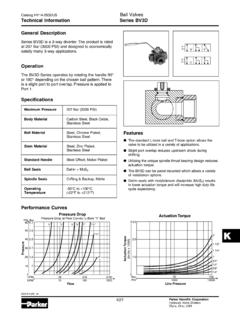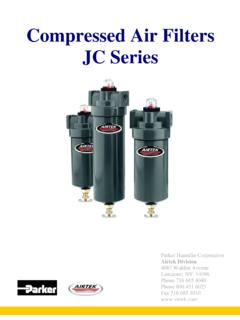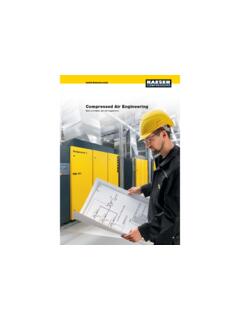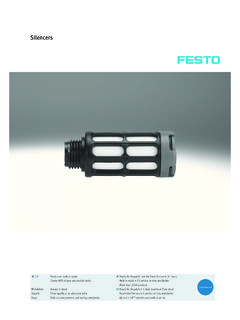Transcription of Introduction to ISO Air Quality Standards - parkerstore.jp
1 Introduction to ISO Air Quality StandardsENGINEERING YOUR (International Standards Organisation) is the world s largest developer and publisher of international is a network of the national Standards institutes of 159 countries, one member per country, with a Central Secretariat in Geneva, Switzerland, that co-ordinates the system. ISO is a non-governmental organisation that forms a bridge between the public and private sectors. On one hand, many of its member institutes are part of the governmental structure of their countries, or are mandated by their government. On the other hand, other members have their roots uniquely in the private sector, having been set up by national partnerships of industry domnick hunter are members of governing bodies such as BCAS (UK), CAGI (USA) and VDMA (Germany), which directly contribute to the development of international Standards for compressed air Quality and are three Standards currently in use which directly relate to compressed air Quality (purity) and testing.
2 These are:ISO8573 series / ISO12500 series / ISO7183 The most commonly used standard is the ISO8573 series and in particular ISO8573-1 of the three Standards should I use?TO SPECIFY THE PURITY OF compressed AIR REQUIRED AT A PARTICULAR POINT IN A compressed AIR SYSTEMISO8573-1:2010TO TEST A compressed AIR SYSTEM FOR ONE OR MORE SPECIFIC CONTAMINANTSISO8573 PARTS 2 TO 9TO VERIFY THE PERFORMANCE OF compressed AIR PURIFICATION EQUPMENTFILTERS - ISO12500 SERIESDRYERS - ISO7183TO BENCHMARK THE PERFORMANCE OF COMPRESSEDAIR PURIFICATION EQUIPMENTFILTERS - ISO12500 SERIESDRYERS - ISO7183 OBJECTIVESTANDARD TO USE2 ISO8573 - the compressed air Quality standardISO8573 is the group of international Standards relating to the Quality (or purity) of compressed air.
3 The standard consists of nine separate parts, with part 1 specifying the Quality requirements of the compressed air and parts 2 9 specifying the methods of testing for a range of :2010 SPECIFIES THE AMOUNT OFCONTAMINATION ALLOWABLEIN EACH CUBIC METRE OF compressed AIRISO8573-2:2007 SPECIFIES THE TEST METHOD FOR OIL AEROSOL CONTENTISO8573-3:1999 SPECIFIES THE TEST METHOD FOR THE MEASUREMENT OF HUMIDITYISO8573-4:2001 SPECIFIES THE TEST METHODFOR SOLID PARTICLE CONTENTISO8573-5:2001 SPECIFIES THE TEST METHOD FOR OIL VAPOUR AND ORGANIC SOLVENT CONTENTISO8573-6:2003 SPECIFIES THE TEST METHOD FOR GASEOUS CONTAMINANT CONTENTISO8573-7:2003 SPECIFIES THE TEST METHODFOR VIABLE MICROBIOLOGICALCONTAMINANT CONTENTISO8573-8:2004 SPECIFIES THE TEST FOR SOLID PARTICLE CONTENT BY MASS CONCENTRATIONISO8573-9:2004 SPECIFIES THE TEST METHODFOR LIQUID WATER CONTENT3 Specifying air Quality (purity) in accordance with ISO8573-1.
4 2010, the international standard for compressed Air QualityISO8573-1 is the primary document used from the ISO8573 series as it is this document which specifies the amount of contamination allowed in each cubic metre of compressed lists the main contaminants as Solid Particulate, Water and Oil. The purity levels for each contaminant are shown separately in tabular form, however for ease of use, this document combines all three contaminants into one easy to use :2010 CLASSS olid ParticulateWaterOilMaximum number of particles per m3 Mass Concentrationmg/m3 Vapour Pressure DewpointLiquid g/m3 Total Oil (aerosol liquid and vapour) - - 1 micron1 - 5 micron mg/m30As specified by the equipment user or supplier and more stringent than Class 11 20,000 400 10- -70 400,000 6,000 100- -40 90,000 1,000- -20 C-14-- 10,000- +3 C-55-- 100,000- +7 C--6--- 5 +10 C--7---5 - 10- - 5-9-----5 - 10-X--- > 10- > 10> 10 Specifying air purity in accordance with ISO8573-1.
5 2010 When specifying the purity of air required, the standard must always be referenced, followed by the purity class selected for each contaminant (a different purity class can be selected for each contaminant if required).An example of how to write an air Quality specification is shown below :ISO 8573-1:2010 Class 8573-1:2010 refers to the standard document and its revision, the three digits refer to the purity classifications selected for solid particulate, water and total oil. Selecting a air purity class of would specify the following air Quality when operating at the standard s reference conditions:Class 1 ParticulateIn each cubic metre of compressed air, the particulate count should not exceed 20,000 particles in the - micron size range, 400 particles in the - 1 micron size range and 10 particles in the 1 - 5 micron size 2 WaterA pressure dewpoint (PDP) of -40 C or better is required and no liquid water is 1 OilIn each cubic metre of compressed air, not more than of oil is allowed.
6 This is a total level for liquid oil, oil aerosol and oil :2010 Class zero Class 0 does not mean zero contamination Class 0 requires the user and the equipment manufacturer to agree contamination levels as part of a written specification The agreed contamination levels for a Class 0 specification should be within the measurement capabilities of the test equipment and test methods shown in ISO8573 Pt 2 to Pt 9 The agreed Class 0 specification must be written on all documentation to be in accordance with the standard Stating Class 0 without the agreed specification is meaningless and not in accordance with the standard A
7 Number of compressor manufacturers claim that the delivered air from their oil-free compressors is in compliance with Class 0 If the compressor was tested in clean room conditions, the contamination detected at the outlet will be minimal. Should the same compressor now be installed in typical urban environment, the level of contamination will be dependent upon what is drawn into the compressor intake, rendering the Class 0 claim invalid A compressor delivering air to Class 0 will still require purification equipment in both the compressor room and at the point of use for the Class 0 purity to be maintained at the application Air for critical applications such as breathing, medical, food.
8 Etc typically only requires air Quality to Class or Class Purification of air to meet a Class 0 specification is only cost effective if carried out at the point of use4 Simple guidelines for the selection of purification equipment1. Purification equipment is installed to provide air Quality and you must first of all identify the Quality of compressed air required for your system. Each usage point in the system may require a different Quality of compressed air dependent upon the application. Using the Quality classification s shown in ISO8573-1:2010 will assist your equipment supplier to quickly and easily select the correct purification equipment necessary for each part of the ISO8573-1:2010 is the latest edition of the standard.
9 Ensure it is written in full when contacting suppliers. Specifying air Quality as ISO8573-1, ISO8573-1:1991 or ISO8573-1:2001 refers to the previous editions of the standard and may result in a different Quality of delivered compressed Ensure that the equipment under consideration will actually provide delivered air Quality in accordance with the Quality classifications you have selected from ISO8573-1 When comparing coalescing filters, ensure that they have been tested in accordance with both the ISO8573-2, ISO8573-4 and ISO12500-1 Ask for independent validation of product performance by a third For peace of mind.
10 Ensure the manufacturer provides a written guarantee of delivered air Quality . 7. Oil-free compressor installations require the same filtration considerations as oil lubricated compressor installations. 8. When considering the operational costs of coalescing filters, only compare the initial saturated pressure loss as dry pressure loss is not representative of performance in a normally wet compressed air system. ISO12500-1 requires pressure losses for coalescing filters to be recorded when the element is Look at the blockage characteristics of the filter. Just because it has a low starting dp, doesn t mean it will remain low throughout the filter element s lifetime.












